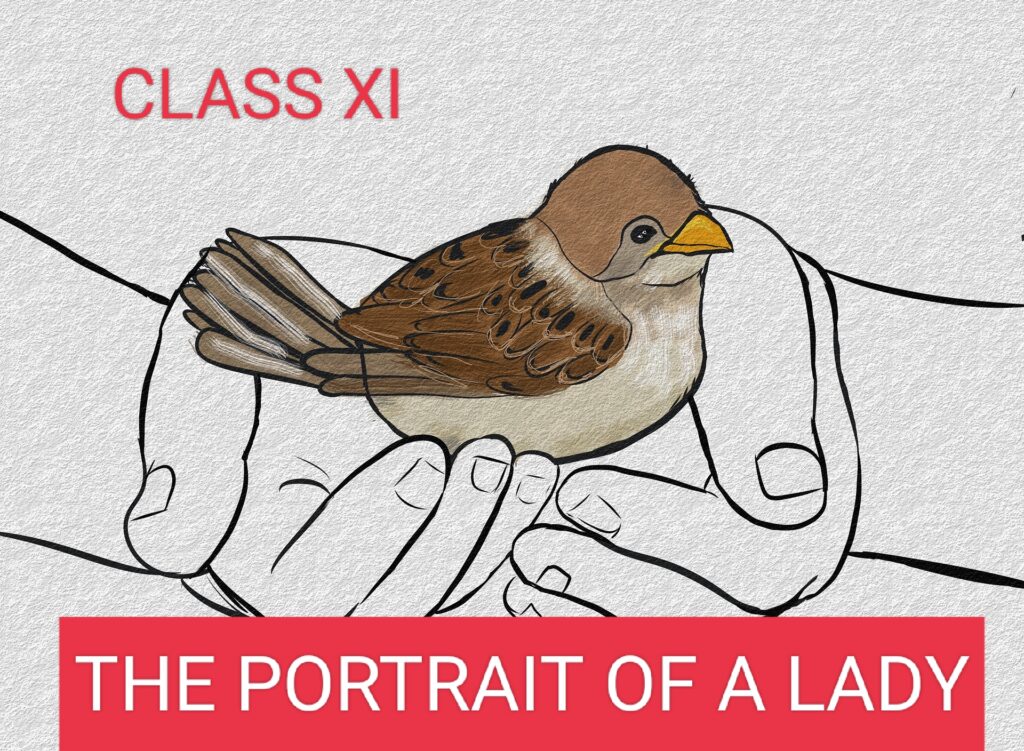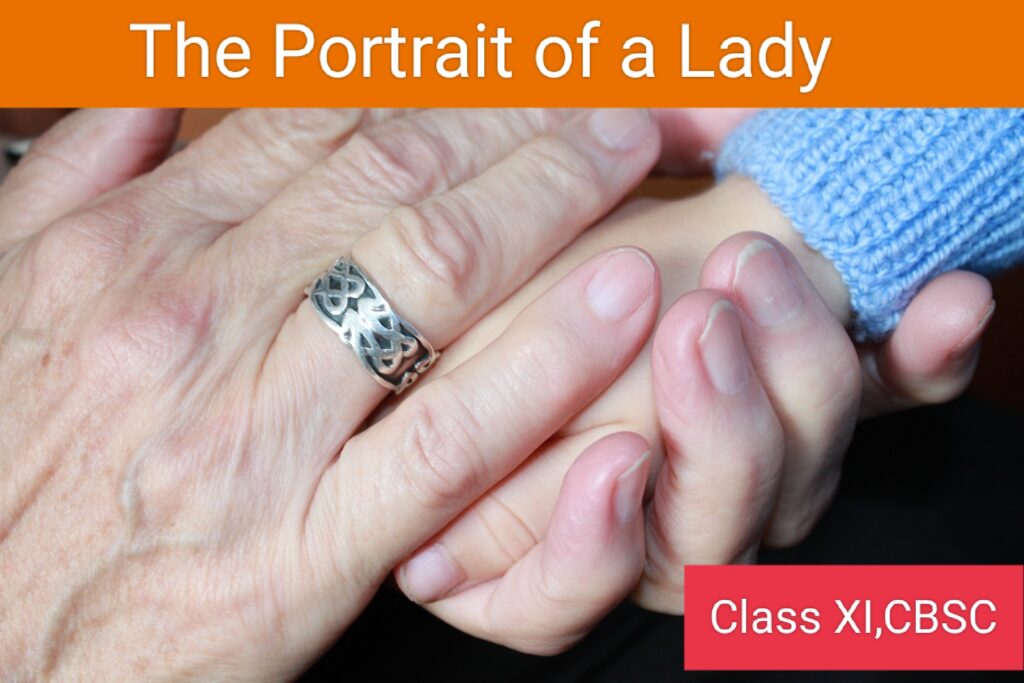CBSC Class XI, Hornbill (Chapter 1)
“The Portrait of a Lady” -Khushwant Singh

About the Author
Khushwant Singh was an eminent Indian author, legal counselor, and writer. He was brought into the world in 1915 in Hadali, Punjab, British India and died in 2014 in New Delhi, India. He is most popular for his books and brief tales, a considerable lot of which deal with the Sikh people group and Indian legislative issues. A portion of his most popular works include “Train to Pakistan,” “I Will Not Hear the Songbird,” and “The Organization of Ladies.” He was likewise a standard writer for a few Indian papers and magazines, and was known for his wit and biting parody. He was awarded the most prestigious Padma Bhushan in 1974, the Padma Vibhushan in 2007 and Sahitya Academy Fellowship in 2010 by the Public authority of India.
Summary of the “The Portrait of a Lady”
Khushwant Singh has written about his grandmother in “The Portrait of a Lady.” He draws portraits that look real. She was quite senior. She had lines on her face. She had white hair. It was hard to believe that she had previously been pretty and young. The picture of his grandfather was displayed in the living room above the mantelpiece. He had a big turban on. His attire was sloppy. He appeared to be at least 100 years old.
The grandmother of Khushwant Singh was a short woman. She was overweight and a little bent. She couldn’t keep her balance. She stumbled throughout the house. One hand had to be on her waist. It was to keep her stoop balanced. She had a rosary in the other hand. She always told the beads stories. As she prayed, her lips moved constantly. She donned white attire. Her pale face was dotted with spots. She resembled wintery mountains covered in snow. She was the epitome of contentment and tranquility. She was quite old and She might not have appeared more older. Over the past two decades, her appearance has remained constant.
His grandmother and Khushwant Singh were good friends. His parents resided in the city. In the village, they left him with her. She cared for him well. He used to be woken up by her every morning. She prepared him for school. She prayed in a sing-song manner in the morning. She had high hopes that he would memorize it. He enjoyed listening to her voice but never bothered to learn it. She would then go get his wooden slate. She had already plastered it with yellow chalk and washed it. She would carry a red pen and an earthenware inkpot. She would bundle them up and give it to him. She would give him a thick, stale chapatti topped with a little sugar and butter. It was breakfast for him. She brought several stale chapattis for the village dogs with her.
His grandmother always accompanied him to school. The temple was connected to the school. The children were taught the alphabet and the morning prayer by the priest. In the veranda, the children sat in two rows. In a chorus, they would sing the alphabet or the prayer. The temple was where the grandmother sat. She would read religious texts. After that, they would walk together home. The temple door was where the village dogs would congregate. Chapattis were thrown at them. Fighting and growling ensued among the dogs.
Then, the narrator’s parents sent him to the city. In their friendship, it marked a turning point. They occupied the same space. However, his grandmother no longer accompanied him to school. The narrator once took a motor bus to an English school.There were no dogs on the strees. Consequently, grandmother began feeding the sparrows.
The years passed. They saw each other less. She would occasionally inquire about what the teacher had taught him. She was skeptical of the teachings at the English school. She was discontent. She didn’t like science or English. She was disappointed that there was no instruction about God and the Bible at her school. One day, the narrator informed her that they were receiving music lessons. She became upset as she considered music to be very indecent. She thought it was only beneficial to beggars and prostitutes. It was not intended for gentlemen.
The narrator attended college. He was given his own room. The friendship that held them together was severed. The grandmother quietly accepted her isolation. With her spinning wheel and praying, she was always busy. She didn’t talk to many people. She took some time to relax in the afternoon. The sparrows would then be fed by her. In the veranda, she sat. She cut the bread into small pieces. She would then scatter them among sparrows. There were hundreds of sparrows there. They made an awful lot of noise. She was sat on by a few of the visitors. Some of them even sat on her head. She smiled, but she didn’t scare them away. She spent the most joyful half of her day feeding the sparrows.
The narrator made the decision to pursue higher education abroad. He was scheduled to be absent for five years. The grandmother was extremely old now. She could pass away anytime. The narrator was concerned. However, the grandmother was unimpressed. She was emotionless. She went to the train station to watch him leave. She prayed as her lips moved. Her hands were busy telling the rosary beads stories. She silently kissed his forehead. The narrator was under the impression that it was their final physical contact.
Five years later, the narrator came home. He was met at the station by his grandmother. She did not appear any younger. She didn’t say a word. She wrapped her arms around him. She continued to say her prayers. She fed the sparrows as usual in the afternoon. She experienced a shift at night. She never prayed. She gathered the local women together. She acquired an old drum. For several hours, she thumped the old drum. She sang about warriors returning home. They needed to get her to stop. She might exert herself too much.
She became ill the following morning. She had a low temperature. She informed them that her time was running out. She realized that she hadn’t said her prayers. She was unwilling to speak. It would be pointless. She disregarded their demands and slept soundly in her bed. She was saying beads and praying. After that, her lips ceased to move. Her lifeless hands dropped the rosary. Her calm, pale face appeared. She was no more. She was spread out on the floor. A red shawl covered her up. Her funeral was being planned .
It was the time of dusk and the sun was going down. A wooden stretcher was brought. Near her body, thousands of sparrows perched. They didn’t yell. The birds were pity for everyone. Bread was brought by the narrator’s mother. She shattered it into tiny crumbs. These crumbs were given to the sparrows but they went unnoticed by the birds. After that, they took her dead body outside. The sparrows silently departed. In the courtyard, the bread crumbs were still there. It appeared that the grandmother’s passing had brought the sparrows here to mourn.

Short Answer Type Questions
1. Provide a sketch of the narrator’s grandfather as depicted in the text “The Portrait of a Lady”
Ans. The narrator’s grandfather’s portrait was displayed in the living room. He was dressed in loose clothing and a turban. He looked like a 100-year-old man who could only have grandchildren with his long, white beard. The author was quite surprised that this man could ever become young.
2. What is Khushwant Singh’s description of his elderly grandmother in “The Portrait of a Lady”?
Ans. According to Khushwant Singh, his grandmother so old that she could not get any older. Wrinkles were all over her face. She was fat, short, and a little bent. It was unbelievable to imagine that she had a husband when she was young and pretty. He almost shuddered at the thought of her as a child.
3. What are the facts that the author could not believe about his grandparents in “The Portrait of a Lady”?
Ans. The fact that the author’s grandfather ever had a wife and children was almost unbelievable. He gave the impression that he could only have a lot of grandchildren. In the case of the author’s grandmother, it was hard to imagine or believe that she had a husband, was ever young and pretty, or played games as a child.
4. The grandmother of the narrator gave the impression of a “winter landscape in the mountains” for what reason?
Ans. The author’s grandmother once wore white, spotless clothing. Her hair was silvery. She was white all over and resembled the snow-covered winter landscape of the mountains. She always said her prayers, which gave her a calm look that was like the white, peaceful mountains.
5. In the village, how did the elderly woman take care of the narrator in the text?
Ans. When the narrator’s parents moved to the city, he was left in charge of his grandmother’s care in the village home. She cared for the child with affection. She gave him a bath, dressed him, fed him, and prepared his backpack before taking him to temple school. She assisted the boy in his classes.
6. Why did the grandmother feed birds and dogs both in the city and the village? What did the routine reveal about her character?
Ans. The elderly woman was a kind person. She had a passion for animals and birds. She gave the street dogs chapattis in the village. She began feeding small birds because there were no dogs around in the city. This demonstrated her noble nature and love for all living things.
7. How can you say that the grandmother was a woman who was very religious?
Ans. The author’s grandmother was exceptionally religious. She recited prayers and counted the rosary beads throughout the day. Inside the temple, she read from the Bible. She was disturbed to learn that the city school did not teach about God or the Bible. She fed the birds in the city and the dogs in the villages.
8. How and why did the elderly grandmother’s death affect the sparrows’ grief?
Ans. The old lady’s friendship or association with sparrows began in the city. She sought the company of the sparrows when she was left alone. Every day in the afternoon, she fed them. She quickly developed a close friendship with the birds. When she passed away, they felt bereaved. They huddled around her and listened intently as the body was removed.
9. I was a good friend of my grandmother’s. When did the friendship begin to form and end?
Ans. In the house in the village, the author and his grandmother became close friends. He was prepared for school by the grandmother, who also took him there. They spent nearly the entire day together. He treated her with love and care until she died. However, in the interim, when they shared a city apartment, that connection soured. The author went to an English school, where he was taught nothing about God or the Bible. She was now unable to assist him with his studies. He finally got his own room, which caused her to distance herself from him. However, the friendship was severed only after her death.
10. Why did the narrator’s grandmother accompany him to school in the text ?
Ans. The grandmother was extremely maternal and devoted to her grandson. The writer was a young boy. She went to the temple school with him to ensure his safety on his way to and from school. She made use of her time in the temple by reading the Bible.
11. In the city, what made the grandmother unhappy?
Ans. The elderly woman’s friendship with her young grandson became strained in the city. She was upsetting herself because she was unable to accompany him to school or assist him with his lessons. She was against English instruction, particularly music lessons. As he got older, the author got his own room. She was upset by the growing distance between them. She was dissatisfied by everything.
12. How did the grandmother feel about school music lessons and English instruction?
Ans. The elderly grandmother was uninformed and had a way of thinking that was out of date. She was skeptical of what was taught in English schools. She was against English education because it did not teach religion. She believed that music was only for prostitutes and beggars.
13. When did the narrator’s friendship with his grandmother end? What was their shared friendship?
Ans. The elderly woman and her growing grandson shared a room in the city for several years, which was their common link. When he went to college and got a room of his own, it broke. She was left alone, but she quietly accepted her distance.
14. In her city home, how did the elderly grandmother keep herself occupied?
Ans. In the city house, the elderly lady calmly accepted the author’s request for a separate room. She recited her prayers while working all day on her spinning wheel. She only took a half-hour break to rest and fed the birds in the afternoon.
15. Briefly describe the grandmother’s friendship with the city’s sparrows.
Ans. The old grandmother made friends with the sparrows because she had lost even her last friendship with the author. She gave the birds small pieces of bread in the afternoon, and some of them even sat on her head and shoulders. The sparrows also grieved for her after she passed away. They surrounded her in a circle of thousands. They didn’t move or make any noise. They refused to consume the provided crumbs. Only after her dead body was removed did they fly away.
16. Briefly describe the grandmother’s celebration of the narrator’s return home after she dropped him off at the station.
Ans. To see her beloved grandson depart, the elderly grandmother went to the train station. She did not express any feelings or sentiments. She only gave him a head kiss. After five years, she was still there to receive him. She seemed very content. She played the drum and sang songs to mark his return in the evening. She became ill from exhaustion and passed away the following day.
17. The grandmother did not stop praying once. When did she depart from that routine, and why?
Ans. The grandmother always said her prayers and counted her beads on time. She only missed them on the day the author returned from aboard. She gathered a group of women, acquired an old drum, beat it, and sang about the author’s return home. She didn’t stray from her routine on that day.
18. Briefly describe the elderly woman’s peaceful passing.
Ans. The grandmother became ill as a result of overthinking at such an old age. She was certain that her time was coming to an end. As a result, she declined to speak with anyone. She desired to recite the rosary’s beads in her final moments of life and pray. The rosary fell from her lifeless hands as her lips gradually stopped moving. She passed away thus peacefully.

Broad Answer Type Questions
1. Describe the author’s evolving relationship with the grandmother in “The Portrait of a Lady”.
Answer: In “The Portrait of a Lady” the author’s grandmother was a woman who was very religious. This is made clear to us by the various ways in which she behaves. She read the Bible every morning when she went to the temple. She constantly counted the rosary beads and mumbled an inaudible prayer at home.
The author was completely reliant on his grandmother when he was young. She played a crucial role in his life. The grandmother made him ready for school and used to take care of his studies. The narrator also enjoyed the company of his grandmother. Their trip to the city marked the turning point in their friendship. She was no longer able to accompany him to school because he took the bus. They shared a room, but she was unable to assist him with his studies. She would inquire about his education. She was skeptical of what the school was teaching. She was upset that nothing was being taught about God and the Bible. The fact that music was also being taught offended her. She kept her disapproval to herself. She never talked to him again after that. He was given his own room when he went to college. This took away their friendship as a common bond. Their feelings for one another, on the other hand, persisted. They still had a deep love for one another.
When the author was travelling abroad for higher education, she went to the railway station to pick him up. She silently kissed his forehead and showed no emotion. The author regarded this as possibly their last physical contact. She greeted him at the station when the author returned after five years. She wrapped her arms around him. She sang songs and beat an old drum in the evening to welcome him home.
2. Briefly describe the pious grandmother depicted in the narrator’s pen drawing.
Answer: The character of narrator’s grandmother is portrayed as a symbol of love, devotion, and care. She was a generous and eminent woman in addition to being a deeply religious and conservative lady. She loved and cared her grandson deeply, just like every other grandmother. She lacked physical attractiveness. She was old, overweight, short, and had a stoop. She walked around the house with one hand on her waist and counted beads as she recited prayers. She was very interested in how her grandson lived in the village, but the friendship ended when they moved to the area. Nevertheless, she always showed peace and contentment.
The way she fed her dogs and sparrows showed her love for the animals. She never interfered with English class, despite her dislike of it. She was calm and collected as she accepted her grandson’s decision regarding her life. Additionally, peace and contentment were achieved during death.
3. Describe narrator’s friendship with his grandmother.
Answer: The narrator’s grandmother played a significant role in his upbringing when he lived in the village with his grandmother as a child. She used to wake him up early by getting up with him. As she bathed and dressed him, she sang her prayers in the hope that the young boy would remember them. For breakfast, she served him a stale chapatti with butter and sugar. They would then all go to school and the temple together. While the author was studying, the grandmother would read holy books to her. Together, they returned home.
A turning point in their relationship occurred when his parents invited them to the city. Despite sharing a bed, she was unable to significantly assist him. She resented science, western education, and music in particular. The common thread of their friendship was eventually severed.

4. Describe the grandmother’s close relationship with the sparrows. How did the sparrows feel about her passing?
Answer: Grandmother loved animals very much and cared a lot about them. She gave leftover chapattis to the village’s street dogs. While she was in the verandah, she started feeding the sparrows. On the verandah, she would break the bread into small pieces in the afternoon. She would distribute the crumbs to the hordes of sparrows that surrounded her. They would perch themselves on her legs, shoulders, and even her head and chirp loudly, enjoying the breeze. It was the most enjoyable half an hour of the day for her.
When the grandmother passed away, the sparrows silently paid their respects to her. The body of her was surrounded by thousands of people. They didn’t chirp or take the grandmother’s breadcrumbs in their hands. After her body was taken for cremation, they silently mourned her passing by flying away.
5. The fact that the schools did not teach anything about God or the Bible really bothered the grandmother. Is it appropriate for morality to be taught in schools? What is your opinion?
Answer : The moral, ethical, and spiritual values of our students have been utterly neglected by our current educational system. Morality and religion are necessary for men to remain civilized. The standard of living is being raised, but not the standard of life. Duty, consideration for others, and compassion have been neglected every now and then. The character crisis is looming large. Our lofty civilization is losing its luster as a result of its lack of high morals and character.
Value education is essential right now.A set of rules that teaches us what is right and wrong are called morals. The practice of religion is morality. The prevalence of social evils is rooted in a lack of moral and spiritual education. Morality teaches man to be good and spreads goodwill. We will have a new generation of misguided youth if we do not provide moral education at the primary level. If a portion of this misguided youth commits robbery, arson, or looting and does nothing to help their family or country; then we can only blame ourselves. The older generation must lead by example in order to instill discipline and morals in the children of today.
6. Elderly people ought not to be neglected, and every effort ought to be made to ensure that they reside with their children and grandchildren. This will foster proper communication between the older and younger generations. -Write down your ideas.
Answer : The elderly people feel the need for physical, moral, financial and emotional support from their children. They frequently live a lonely life because their children leave them alone. Even their virtues turn into significant vices.A vast divide appears between elderly people and their children when they are left alone. The temporary separation that may occur as a result of circumstances is beneficial because it fosters love and respect. It is difficult for the elderly to alter their way of life because they live in their own world. They only want love and respect from the new generation.It is true that our current generation has its own priorities, but they should not neglect the requirements of the elderly.
The perspective of the elderly people changes when they live with their children. They attempt to adjust to the new environment because they are experienced. Giving older people a little love, affection, and care is a better way to solve their problems than building them homes. We have to Keep in mind that one day we will also be like them. So,a complete attitude shift is required. The younger generation can learn a lot about the latest gadgets and technologies from the older generation, which in turn can enrich the younger generation. This will help to fix the generation gap and lead to a happy, healthy society.
For more such contents stay tuned to Webacademix

